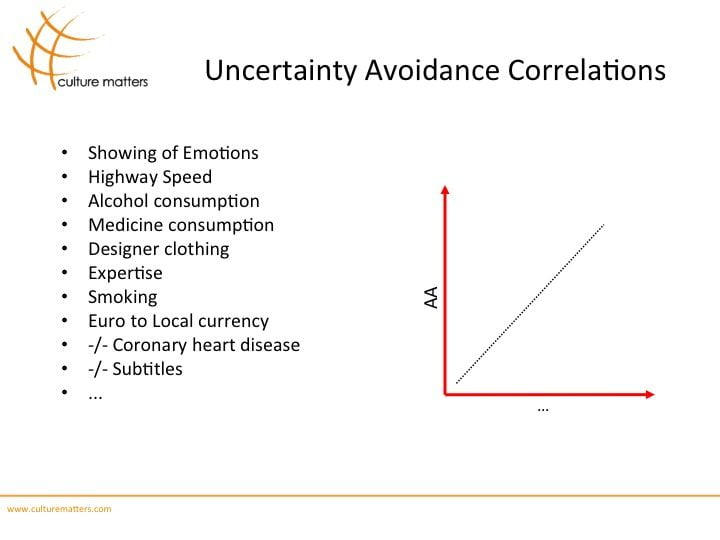What are Good Examples of Uncertainty Avoidance?
Since this is (or at least I think it is) one of the most difficult dimensions of Professor Geert Hofstede to explain, it makes sense to give some extra context and examples of Uncertainty Avoidance. If you’re not familiar with this uncertainty avoidance index at all, I strongly suggest you read this article first. It will give you a good overview of the breadth of this Hofstede cultural dimension.
If you’re just interested to see a wide range of examples of uncertainty avoidance, read on.
What is Uncertainty Avoidance and What Isn’t?
To understand what uncertainty avoidance index is and what it isn’t let me use a question and a multiple choice answer.
The question: “Would people from countries that score low on this dimension be more likely to bungee jump?”
Possible answers:
- Yes
- No
- Bungee jumping has nothing to do with uncertainty avoidance
The correct answer is 3. Bungee jumping has nothing to do with uncertainty avoidance. Bungee jumping falls in the category of so-called “calculated risks”. Sure enough, there are risks involved when you bungee jump, but there are also risks involved when you drive a car or get on a plane. Driving a car and getting on a plane are also calculated risks.
Starting your own business is not a calculated risk. Even if you create a business plan, as soon as you start executing it, reality gets in the way and unpredictable things will happen.
Therefore entrepreneurship is part of uncertainty avoidance and bungee jumping isn’t.
Correlations with Uncertainty Avoidance Index
I found that to best understand this Uncertainty Avoidance index it works to link real-life examples (or phenomena) to these dimensions in terms of correlations.
Below you see an image with an incomplete (!) list of correlations with Uncertainty Avoidance. I’ll explain them below the image. So in a culture that scores high on Uncertainty Avoidance (in the image uncertainty avoidance is abbreviated as AA which stands for Anxiety Avoidance; the vertical axis), people will do/show/consume/etc. more of the points listed.
- Showing of Emotions: Compare a minor head-to-tail car collision in Rome with one in London. Most likely there will be more “Emotional Fireworks” in Rome!
- Highway Speed: Correlates directly with Uncertainty Avoidance. The higher the score on this dimension, the faster people are (legally) allowed to drive, but also drive fast(er), even when it’s not allowed. The “need for speed” is in this dimension.
- Alcohol Consumption: The higher the score on this dimension, the more alcohol people consume. The Brits (low scoring culture) are by far not the highest beer consumers in the world… The Czechs are, followed by the Germans.
- Smoking: Something that is slowly banned in the Western World, but still there are significant differences in cultures and smoking.
If you consider smoking, alcohol consumption, and speeding, you can see that they are all in some form or shape a way of expressing one’s emotions. The point here is that “showing of emotions” does not mean that people scream and shout all the time or go about life crying all the time. There are different ways of expressing your emotions.
- Medicine Consumption: Same as the previous point; whereby France tops the list in the EU.
- Designer Clothing: As they say “Better to be overdressed than to be underdressed“. Italians spend the most on designer clothing in the EU. They also score high on Uncertainty Avoidance.
- Expertise: This is where people put importance on official and academic titles. E.g. the “Herr Dr. Dr.” in Germany.
- Euro to Local Currency: In a couple of European countries (e.g. France) the prices in supermarkets are mentioned in Euros, but also in the old currency (French Francs in this example).
- Coronary heart disease: This is an inverse or negative correlation. In other words, countries that score high on Uncertainty Avoidance and let out their emotions suffer less of coronary heart disease. You could say that blowing off steam is good for your health.
- Subtitles: Also a negative correlation. What this means is that high scoring cultures audio-dub TV programs, rather than subtitle it. Example: James Bond speaks German in Germany. There are exceptions (e.g. Flanders in Belgium).
I can think of more examples of uncertainty avoidance and the challenge here is for you to decide which way they correlate: positive or negative:
- Drinking bottled water instead of tap water?
- Securing WIFI networks?
- …?
See the Scores of All Countries on Uncertainty Avoidance Index.
I hope that with these examples of uncertainty avoidance this dimension has become a bit clearer.
If you’re interested in seeing an overview of all the countries in the world and their respective score on this dimension, go here.
Examples of the dimension hierarchy or power distance can be found here.
What did I miss? Comments? Leave them at the end of this post
Get a Taste of How Chris Presents, Watch his TEDx Talk
 Call Direct: +32476524957
Call Direct: +32476524957
 European Office (Paris) Whatsapp: +32476524957
European Office (Paris) Whatsapp: +32476524957
The Americas (USA; Atlanta, GA; también en Español): +1 678 301 8369
Book Chris Smit as a Speaker
If you're looking for an Engaging, Exciting, and Interactive speaker on the subject of Intercultural Management & Awareness you came to the right place.
Chris has spoken at hundreds of events and to thousands of people on the subject of Cultural Diversity & Cultural Competence.
This is What Others Say About Chris:
- “Very Interactive and Engaging”
- “In little time he knew how to get the audience inspired and connected to his story”
- “His ability to make large groups of participants quickly and adequately aware of the huge impact of cultural differences is excellent”
- “Chris is a dedicated and inspirational professional”
In addition, his presentations can cover specific topics cultural topics, or generally on Cultural differences.
Presentations can vary anywhere from 20 minutes to 2 hours and are given World Wide.
Book Chris now by simply sending an email. Click here to do so.
Read more about what Chris can do for you.
- Percentage of People Rating a Presentation as Excellent 86%
- Rating the Presentation as Practical 89%
- Applicability of Chris' presentation 90%
About Peter van der Lende

Peter has joined forces with Culture Matters.
Because he has years and years of international business development experience joining forces therefore only seemed logical.
Being born and raised in the Netherlands, he has lived in more than 9 countries of which most were in Latin America.
He currently lives in Atlanta, Georgia (USA) with his family.
You can find out more at https://expand360.com/
Or find out what Peter can do for you here.
- 178 Toby Mildon - 8 May 2024
- 177 Mark Steinberg - 22 February 2024
- Japanese versus Western Culture - 24 January 2024




Dear Chris,
thanks for this nice presentation for the uncertainty avoidance dimension..any books or articles to recommend? I am doing a dissertation about cultural differences and work values and I am thinking of using this dimension! thank you maria
Hi Maria,
Sorry for the late reply. Lots of Spam messages.
I think you should use all four of Hofstede’s dimensions.
I could recommend my own book to start with 😉
hy my dear firnds sorry for intrept you in midddle of conversation. i think uncertainty avoidence is
Uncertainty Avoidance, “a society’s tolerance for uncertainty and ambiguity”. It reflects the extent to which members of a society attempt to cope with anxiety by minimizing uncertainty. …
Acceptance of assumed causes or explanations of a situation as facts to escape the discomfort associated withambiguity or uncertainty.
which we learnd from the latest lecture from our profesr
You’re quite right!
I am an undergrad student doing a paper on the GLOBE project and would like more articles on the same subject matter as the project. Thanks!
Hi Simeon,
Thanks for the comment and thanks for the compliment.
If you have any “specific wishes” you can always email me directly 😉
Glad I could help.
Kind regards,
Chris
This is better than the previous site i visited.. thanks 🙂
My pleasure.
What particularly did you like about it?